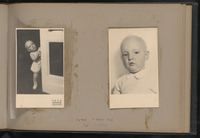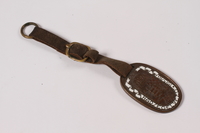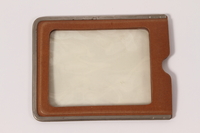Overview
- Interviewee
- Catherine Veres
- Interviewer
- Peter J. Veres
- Date
-
undated:
- Credit Line
- United States Holocaust Memorial Museum Collection, Gift of Peter Veres
Physical Details
- Language
- English
- Extent
-
18 sound cassettes (90 min.).
Rights & Restrictions
- Conditions on Access
- There are no known restrictions on access to this material.
- Conditions on Use
- Restrictions on use. Donor retains copyright. Third party use requests must be submitted to the donor.
- Copyright Holder
- Peter J. Veres
Administrative Notes
- Legal Status
- Permanent Collection
- Provenance
- Peter Veres donated his collection of family papers, audio recordings, photographs, film, and memorabilia to the United States Holocaust Memorial Museum Archives in May 2010. The Museum's Oral History Branch received the audio testimony with Kati Veres in March 2011.
- Special Collection
-
The Jeff and Toby Herr Oral History Archive
- Record last modified:
- 2023-11-16 09:20:23
- This page:
- https://collections.ushmm.org/search/catalog/irn43092
Download & Licensing
- Request Copy
- See Rights and Restrictions
- Terms of Use
- This record is digitized but cannot be downloaded online.
In-Person Research
- Available for Research
- Plan a Research Visit
Contact Us
Also in Peter Veres family collection
The collection consists of artifacts, audio recordings, documents, film, and photographs relating to the experiences of the Deutsch, Krausz, and Veres families in Budapest, Hungary, prior to and during the Holocaust, when some family members were deported to camps or lived in hiding, and after their postwar emigration to the United States.
Date: 1844-2010

Peter Veres family papers
Document
The Peter Veres family papers consist of family records, photographs, genealogical materials, immigration documents, and reparations records documenting the history of a Jewish family in Budapest, their experiences with labor camps, hiding, and deportations during World War II and the Holocaust, and their immigration to New York in 1949. The Kato Krausz Veres materials include birth and marriage certificates, identification papers, an account book, education records, health records, an obituary, and other material documenting Kati’s childhood in Budapest, experiences in Hungary during the 1930s and 1940s, religious conversion, immigration to the United States, and death in 1994. This series also includes letters Kati wrote to her parents in October 1938 while she was in London for Peter’s birth, an identification document for Kati’s son, Peter Veres, and an obituary for her sister in law, Agnes Hardy. The George Veres materials include birth certificates, childhood letters, identification papers, education records, labor camp records, health records, an obituary, and other material documenting George’s childhood in Budapest, his operation of a Goodyear store in Budapest, experiences in forced labor during the war, religious conversion, immigration to the United States, and death in 1974. The Béla Krausz materials include birth and marriage records, school records, military papers, life insurance records, and correspondence documenting Béla’s birth in Eger, legal education and practice, marriage to Lenke Deutsch, military service, and internment before his deportation and death. The Lenke Deutsch Krausz materials include identification papers, an account book, date books, journals, correspondence, education records, Budapest property records, emigration records, a death certificate, and obituaries documenting Lenke’s childhood in Budapest, experiences in Hungary during the 1930s and 1940s, immigration to the United States, and death in 1968. This series also includes obituaries and other materials about her parents Vilmos and Irene Deutsch, brother Laszlo Danos, and relative Emanuel Müller. The Gabor Krausz Carelli materials include birth certificates, identification papers, education and financial records, address and date books, immigration records, news clippings, correspondence, and other material documenting Gabor’s childhood in Budapest, immigration to the United States in 1939, and his family’s efforts to contact him during the war. This series also includes awards, opera posters, programs, publicity records, schedules, and USO correspondence documenting Gabor’s singing career in Italy, the United States, and Hungary. The Ármin and Sári Veres materials include birth certificates, identification papers, love letters, marriage records, death announcements, photographs of Sári’s funeral and the Veres’ tombstones, and other material documenting the Veres’ lives in Hungary. This series also includes records documenting Veres and Hajossy relatives including Albert and Fani Hajossy, Fanni Hegedus Hercz, Salamon Löwy, Samuel and Marton Roth, and Jacob, Markus, and Moricz Schiff, as well as research into Schiff and Hajossy family history. Photographic materials include seven family photo albums, one of which was dismantled at some point, documenting the Vilmos Deutsch and Irene Müller family, Lajos Krausz and Linka Klein family, Ármin Veres and Sári Hajossy family, Béla Krausz and Lenke Deutsch family, and George Veres and Kati Krausz family. The albums primarily include photographs of family members, but some also include additional photographs and documents. For example, the Vilmos Deutsch and Irene Müller family album includes the couple’s 1917 passports, 1986 photographs of a silver menorah, and photographs of the buildings in Budapest that used to be the Deutsch family apartment, Kati’s school, and Goodyear store operated by George Veres. The Lajos Krausz and Linka Klein family album includes family trees and childhood letters from the Krausz children to their parents. The Béla Krausz and Lenke Deutsch family album includes marriage documents and bookplates, and the “Kató and Gabi growing up” album includes documents and photographs related to Beniamino Gigli. Genealogical materials include family trees, family history, and unidentified 19th century Hebrew materials documenting the Deutsch/Müller family, the Krausz family, the Roth/Veres family, and the Schiff/Hajossy family. Immigration documents include letters Peter Veres’ family sent to Sári Veres from Italy after leaving Hungary and preparing to immigrate to the United States and records documenting the family’s immigration and naturalization process in America. These files also include records documenting the family’s registration as refugees in Italy and records documenting alternative plans to emigrate to Canada or Costa Rica. Reparations records include correspondence, forms, affidavits, and payment notifications documenting the Veres family’s efforts to receive reparations for Béla Krausz’s death, George Veres’ forced labor, and the theft of valuables.

Pair of white leather Masonic gloves with button cuffs owned by a Hungarian Jewish emigre
Object
White leather ceremonial gloves that originally belonged to Vilmos Deutsch. They were acquired through his membership in the Freemason society. White kid gloves were presented to newly initiated members; a man's pair for the member and a woman's pair for his wife or betrothed. They were symbolic and not intended for use and represented the ideal that the work of his hands should be pure and spotless. Vilmos, who died in 1935, was from a large, Orthodox Jewish family in Budapest, Hungary. The gloves were inherited by his daughter, Lenke. In March 1944, Hungary was occupied by Nazi Germany. Lenke's husband, Bela, was deported in July to a concentration camp where he was killed. In November, Lenke went into hiding with her daughter Kati and her children, and her son-in-law’s family. The city was liberated by Soviet forces in January 1945. Lenke brought the gloves with her when she left Hungary with Kati and her family in January 1949 for the United States.

White leather wrist length left hand Masonic glove with side vent owned by a Hungarian Jewish emigre
Object
White leather ceremonial left hand Masonic glove that originally belonged to Laszlo Danos, born Deutsch. It was acquired through his membership in the Freemason society. White kid gloves were presented to newly initiated members; a man's pair for the member and a women's pair for his wife or betrothed. They were symbolic and not intended for use; they represented the ideal that the work of his hands should be pure and spotless. Laszlo, who died of a heart attack in 1934, was part of a large, Orthodox Jewish family in Budapest, Hungary. His wife gave the glove to his sister Lenke. In March 1944, Hungary was occupied by Nazi Germany. Lenke's husband, Bela, was deported in July to a concentration camp where he was killed. In November, Lenke went into hiding with her daughter Kati and her children, and her son-in-law’s family. The city was liberated by Soviet forces in January 1945. Lenke brought the gloves with her when she left Hungary with Kati and her family in January 1949 for the United States.

WWI Hungarian War Supporter copper watch fob acquired by a Jewish army veteran
Object
World War I Hungarian War Supporter copper watch ornament originally owned by Bela Krausz, issued for contributions to military aid for the year 1915/16. Bela, an Orthodox Jew and WWI veteran, was arrested in Budapest on May 31, 1944, following the occupation of Hungary by Nazi Germany on March 19. He was deported in July to an unknown concentration camp where he was killed. In November, his wife Lenke went into hiding with their daughter Kati and her children, and her son-in-law’s family. The city was liberated by Soviet forces in January 1945. Lenke brought the watch fob with her when she left Hungary with Kati and her family in January 1949 for the United States.

Gold and blue enamel Masonic medal with the compass and square emblem owned by a Jewish Hungarian emigre
Object
Square and compass Masonic medal that originally belonged to Armin Veres, born Roth. It was possibly a sign of office for a Senior Deacon in the Galilei Freemason Lodge in Budapest, Hungary. Armin, a lawyer, lived in Budapest with his family. On March 19, 1944, Nazi Germany occupied Hungary and antisemitic laws went into effect. The apartments of many Jews were confiscated and several family members moved in with Armin and his wife, Sari. By June 23, all Jews were forced to move into segregated yellow star buildings and they moved in with a family friend. In November, Armin and Sari were sent to the ghetto, and their children went into hiding. The Soviet Army liberated Pest on January 14, 1945, and Armin and Sari were reunited with their family. Armin died April 1, 1945. The collar was brought to the United States by his son, George, when he emigrated in March 1949.

Masonic tie pin with a gold compass and square emblem owned by a Hungarian Jewish emigre
Object
Gold and dark blue enamel Freemason tie tack belonging to Armin Veres, born Roth. He was a member of the Galilei Freemason Lodge in Budapest, Hungary. Armin, a lawyer, lived in Budapest with his family. On March 19, 1944, Nazi Germany occupied Hungary and antisemitic laws went into effect. The apartments of many Jews were confiscated and several family members moved in with Armin and his wife, Sari. By June 23, all Jews were forced to move into segregated yellow star buildings and they moved in with a family friend. In November, Armin and Sari were sent to the ghetto, and their children went into hiding. The Soviet Army liberated Pest on January 14, 1945, and Armin and Sari were reunited with their family. Armin died April 1, 1945. The collar was brought to the United States by his son, George, when he emigrated in March 1949.

Plastic identification badge holder used by a Hungarian Jewish emigre
Object
Cardboard and plastic wallet that belonged to Hungarian opera singer Gabor (Gabi) Carelli. Gabor was part of an Orthodox Jewish family from Budapest. He traveled to the United State in 1939, and toured with various opera companies. His family in Hungary was persecuted by the Fascist, antisemitic government from 1940-1944; some were sent to forced labor and concentration camps. In March 1944, Nazi Germany occupied Hungary and members of his family were deported or went into hiding until Budapest was liberated by the Soviet Army in January 1945. His father was killed in a camp in 1944, but his mother, his sister, and her family came to the US in 1949.
Freemason white knit cotton gloves presented to a Hungarian Jewish emigre
Object
Pair of white cotton knit gloves presented to George Veres when he became a member of a New York chapter of the Freemasons in 1950-1951. White gloves, usually kid leather, were presented to newly initiated members. They were symbolic and not intended for use and represented the ideal that the work of his hands should be pure and spotless. George emigrated from Hungary to the United States with his family in March 1949. In 1940, George, who was Jewish, was sent to a forced labor camp by the Fascist, antisemitic government of Hungary. From 1940-1944, he was in and out of camps near Budapest. In March 1944, Nazi Germany occupied Hungary. That November, George's wife, Kati, and their two young sons, Peter and Paul, went into hiding. On December 12, 1944, George escaped his camp and found refuge in a Swedish emergency hospital. Pest was liberated by the Soviet Army on January 14, 1945, and George was reunited with his family. In January 1949, the family emigrated to the United States.
Ceremonial Masonic blue and white ribbon collar owned by a Hungarian Jewish emigre
Object
Ceremonial blue and white ribbon collar that originally belonged to Armin Veres, born Roth. It was acquired through his membership in the Galilei Freemason Lodge in Budapest, Hungary. Armin, a lawyer, lived in Budapest with his family. On March 19, 1944, Nazi Germany occupied Hungary and antisemitic laws went into effect. The apartments of many Jews were confiscated and several family members moved in with Armin and his wife, Sari. By June 23, all Jews were forced to move into segregated yellow star buildings and they moved in with a family friend. In November, Armin and Sari were sent to the ghetto, and their children went into hiding. The Soviet Army liberated Pest on January 14, 1945, and Armin and Sari were reunited with their family. Armin died April 1, 1945. The collar was brought to the United States by his son, George, when he emigrated in March 1949.
Oral history interview with Peter Veres
Oral History
Peter Veres discusses his family’s arrival at Ellis Island in March 1949 and history in Hungary and New York.



